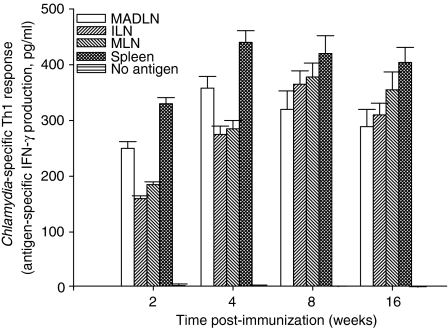Figure 2.
Chlamydia-specific Th1 response induced following intranasal administration of a recombinant influenza virus expressing an immunodominant T-cell epitope from C. trachomatis MOMP (PR8-TINK). Mice were immunized by intranasal administration of PR8-TINK and at the indicated time periods T-cell enriched cells were prepared from the spleen, mandibular, iliac and mesenteric lymph nodes (MADLN, ILN and MLN, respectively), according to standard procedures.25 Purified T cells (1 × 105 per well) were stimulated with splenic APCs plus chlamydial antigen (UV-inactivated EBs) in tissue culture plates for 5 days. At the end of the incubation period, the supernatants were collected and assayed for IFN-γ content by a quantitative sandwich ELISA, as previously described.25 The concentration of the cytokine in each sample (pg/ml) was obtained by extrapolation from a standard calibration curve generated simultaneously. Data were calculated as the mean values (± SD) of triplicate cultures for each experiment. The results were derived from at least three independent experiments. Control cultures containing T cells and APCs without chlamydial antigen showed extremely low measurable amounts of IFN-γ in the range of 0–5 pg/ml. Antigen-specific IFN-γ secretion by activated T cells is the measure of Th1 response, as previously established.25

